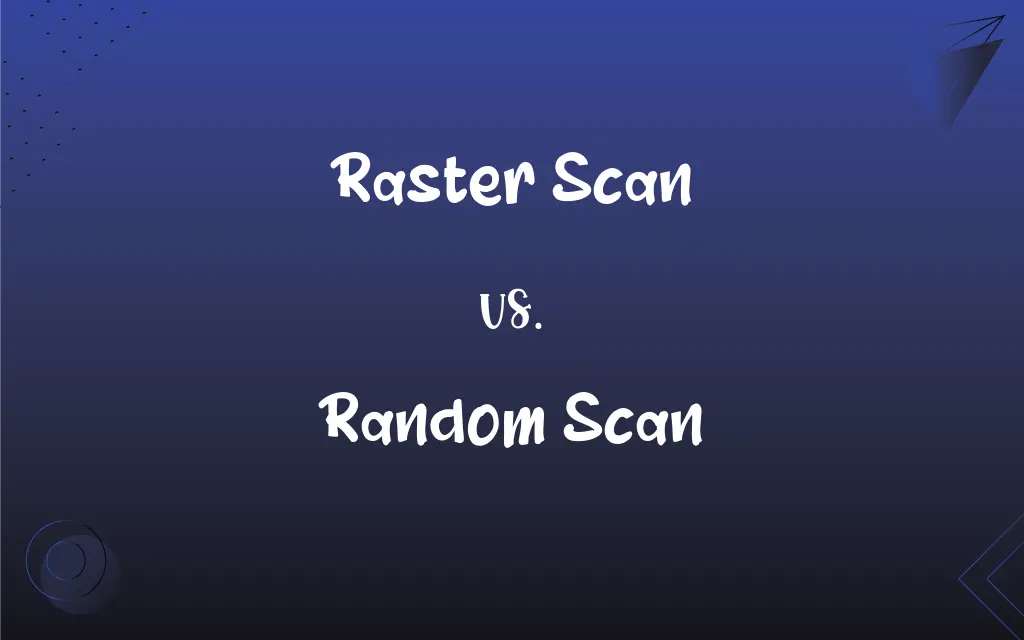Raster Scan vs. Random Scan: What's the Difference?
Edited by Aimie Carlson || By Janet White || Published on February 2, 2024
Raster scan displays images by drawing lines horizontally across the screen; random scan draws images by directing the electron beam to draw only the needed lines.

Key Differences
Raster scan systems display images by drawing a series of horizontal lines across the screen, one after the other, from top to bottom. In contrast, random scan systems draw images by directing the electron beam directly to the points or lines that need to be displayed, without following a specific order.
The raster scan technique is commonly used in standard TVs and computer monitors, where the screen is refreshed line by line in a regular pattern. Random scan, on the other hand, is typically used in vector monitors and certain types of graphic displays, where it draws only the necessary lines for shapes or objects.
Raster scan displays are capable of rendering complex images and color variations, making them ideal for detailed graphics and video. Conversely, random scan systems are better suited for displaying line-based graphics, such as wireframe models, where high refresh rates are necessary.
The resolution of a raster scan display is fixed, based on the number of rows and columns it can display. In random scan systems, resolution is not fixed and can be very high, as the beam can move to any point on the screen directly.
Raster scan systems are generally slower in rendering images compared to random scan systems, due to the sequential nature of the scanning process. Random scan systems can redraw images faster, especially when dealing with simpler line-based graphics.
ADVERTISEMENT
Comparison Chart
Display Method
Sequential horizontal lines
Direct drawing of lines/points
Common Usage
TVs, computer monitors
Vector monitors, graphic displays
Image Complexity
Suitable for complex and color images
Best for line-based graphics
Resolution
Fixed, based on pixel grid
High, not pixel-based
Rendering Speed
Slower due to sequential process
Faster for simpler graphics
ADVERTISEMENT
Raster Scan and Random Scan Definitions
Raster Scan
Raster scan displays images by continuously refreshing horizontal lines across the screen.
Video game graphics are often rendered using raster scan technology for detailed imagery.
Random Scan
Random scan is a display method where the electron beam is directed to draw only specific lines needed for an image.
Random scan is used in air traffic control monitors for sharp, line-based graphics.
Raster Scan
Raster scan method constructs pictures by updating screen pixels in a horizontal left-to-right and top-to-bottom order.
High-definition TVs utilize raster scan for delivering crisp and vibrant visuals.
Random Scan
Random scan involves directly drawing geometric shapes on the screen, bypassing unneeded areas.
Engineering design monitors often use random scan for high-speed line rendering.
Raster Scan
Raster scan method involves illuminating screen pixels row by row in a horizontal pattern.
Computer monitors typically employ raster scan for consistent image quality.
Random Scan
Random scan technology draws images by moving the beam to draw directly from point to point.
In CAD systems, random scan provides precise rendering of line drawings.
Raster Scan
Raster scan is a technique where a beam moves across the screen in a line-by-line fashion to create an image.
The clarity of images in digital projectors is achieved through raster scanning.
Random Scan
Random scan, also known as vector scan, creates images by connecting specific points with lines, not in a sequence.
Oscilloscopes use random scan to display electrical waveforms accurately.
Raster Scan
Raster scan is a display technique where images are created by a sequence of horizontal lines scanned from top to bottom.
Most modern televisions use raster scan to display images smoothly.
Random Scan
Random scan is characterized by its direct approach to image rendering, focusing only on essential lines.
In scientific visualizations, random scan is preferred for its efficiency in displaying complex vector graphics.
FAQs
How does raster scan work?
Raster scan illuminates screen pixels sequentially from top to bottom in horizontal lines.
What is a raster scan display?
Raster scan is a method where images are displayed by scanning horizontal lines across the screen.
Is the resolution in raster scan fixed?
Yes, raster scan has a fixed resolution based on its pixel grid.
Can raster scan display detailed images?
Yes, raster scan is ideal for complex and color-rich images.
Where is random scan typically used?
Random scan is used in vector monitors, CAD systems, and oscilloscopes.
Are random scan images less complex?
Yes, random scan is better suited for simpler, line-based graphics.
Is random scan suitable for TV displays?
No, random scan is not typically used for TVs due to its focus on line-based graphics.
What devices use raster scan?
TVs, computer monitors, and digital projectors commonly use raster scan technology.
How does random scan create images?
Random scan creates images by connecting specific points directly, without a set sequence.
Can both raster and random scan be used together?
It's uncommon to use both in the same device, as they serve different purposes.
Can raster scan handle high-speed rendering?
Raster scan is slower in rendering compared to random scan, especially with complex images.
Can raster scan be used for CAD?
Raster scan can be used for CAD, but random scan might be preferred for precision in line rendering.
How does raster scan affect image quality?
Raster scan provides consistent image quality with detailed color rendering.
What is random scan?
Random scan is a display technique that draws images by directing the beam to specific points or lines.
Is random scan good for video games?
Random scan is not ideal for video games, which often require complex, color-rich graphics.
Does random scan have a fixed resolution?
No, random scan can achieve high resolution as it's not limited by a pixel grid.
Which is faster, raster or random scan?
Random scan is generally faster for simpler graphics, while raster scan is better for detailed images.
What kind of graphics are best for random scan?
Line-based graphics, such as wireframes and vector drawings, are best for random scan.
About Author
Written by
Janet WhiteJanet White has been an esteemed writer and blogger for Difference Wiki. Holding a Master's degree in Science and Medical Journalism from the prestigious Boston University, she has consistently demonstrated her expertise and passion for her field. When she's not immersed in her work, Janet relishes her time exercising, delving into a good book, and cherishing moments with friends and family.
Edited by
Aimie CarlsonAimie Carlson, holding a master's degree in English literature, is a fervent English language enthusiast. She lends her writing talents to Difference Wiki, a prominent website that specializes in comparisons, offering readers insightful analyses that both captivate and inform.
































































